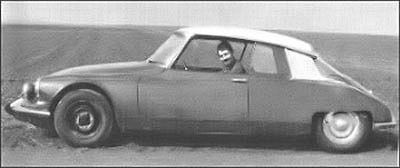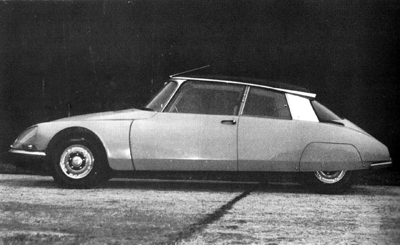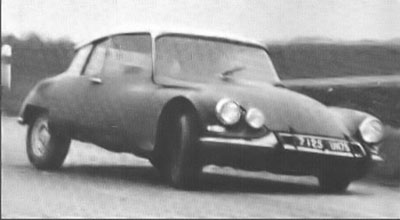[Unknown Citroëns] Citroën DS 27: the project that should have dominated the roads
- Jérémy

- Jun 29
- 3 min read

The winds of change were blowing through Citroën in the late 1960s. After decades of turbulence following the death of its founder, André Citroën, the double chevron brand had regained its former grandeur. The DS, launched in 1955, had become a true phenomenon, dominating the French market with nearly 30% of new car sales, equivalent to approximately 1.25 million vehicles per year. Its avant-garde styling and revolutionary hydropneumatic suspension made it an icon. However, one Achilles' heel persisted: its engine. Despite the engineers' efforts, the DS's four-cylinder engine, though capable, no longer matched the ambitions of a brand that aspired to compete with the global automotive elite. To definitively assert its position and consolidate its status as an industry giant, Citroën made the bold decision to develop a new flagship, an emblematic limousine that would be a resurrection of André Citroën's visionary spirit and his legendary Traction 22 CV.
The genesis of Project S: a sporty vision for the DS
It was in this context of success and ambition that "Project S" was born in 1966. Citroën's Design Office team embarked on the development of a model based on DS components, but with a decidedly more sporty, exclusive, and prestigious orientation. The objective was clear: to provide the DS, whose futuristic styling and revolutionary hydropneumatic suspension were unparalleled, with an engine commensurate with its aspirations. This project, also known as DS 27, was much more than a simple improvement. It aimed to design a car that would not only crown the Citroën range but also establish itself as the benchmark limousine in France, rivaling pre-war greats such as Bugatti, Delahaye, Delage, or Panhard. Citroën engineers, despite their expertise in optimizing four-cylinder engines, recognized the need for a more powerful engine, ideally a six-cylinder, to realize this vision. The first prototype coupe equipped with a new engine, a Maserati V6, was assembled as early as 1967, even before the signing of the PARDEVI agreement. This vehicle, designed by the Design Office and bodied by the Chausson workshop, displayed a refined sporty line, subtly inspired by the original DS, foreshadowing what Citroën aspired to achieve with this ambitious model.
From Project S to SM: italian influence and the realization of a dream
The quest for an adequate engine for Project S was fraught with challenges. French taxation heavily penalized vehicles equipped with engines over 2.8 liters, and Citroën did not possess the in-house technology to design a light, powerful, and compact six-cylinder engine of that displacement. The solution finally came from Italy, under the aegis of Fiat. On October 25, 1968, the PARDEVI agreement was signed, marking a decisive turning point. Fiat acquired 49% of Citroën's shares from Michelin and, simultaneously, acquired Maserati from the Orsi family. This strategic alliance opened the doors of Italian engineering know-how to Citroën, precisely when the French brand was seeking to inject new momentum into its ambitious projects. Engineer Alfieri Maserati, renowned for creating the legendary 4,146 cm³ V8 for the Indy, played a key role in this collaboration. He transformed his V8 into a new 2,670 cm³ V6 specifically for Citroën. This engine, developing 192 hp at 6,000 rpm, offered the power, compactness, and potential expected, placing Citroën on par with prestigious competitors such as Jaguar or Mercedes S-Class. A second coupe prototype, also produced by Chausson, emerged the following year and was even tested in rallies by the excellent driver M. Waldegaard, demonstrating Citroën's commitment to evaluating not only the elegance but also the performance of this extraordinary vehicle. While Project S, or DS 27, was not launched in series under this name, it is undeniably the spiritual father of the Citroën SM. This supercar, officially launched in 1970, adopted the Maserati engine and some of the ambitions of Project S, thus realizing part of Citroën's dream of a grand touring sports car. The exact reasons for the abandonment of the DS 27 as a standalone model remain debated, potentially related to fiscal considerations, production costs, or a change in strategy after Maserati's integration into the development of an entirely new model.
Automotive manufacturers' archives are full of fascinating projects that never went beyond the prototype or concept stage. Citroën, with its history rich in innovations and daring, is no exception. Project S, or DS 27, is a perfect illustration of this. This elegant and powerful coupe, powered by a Maserati heart, represents a little-known but essential chapter in the brand's history. It testifies to Citroën's ambition to position itself at the pinnacle of luxury and performance automobiles, an ambition that was partly realized with the SM. While the DS 27 never graced our roads in series production, it remains a symbol of an era when Citroën dreamed big, thus perpetuating André Citroën's visionary legacy and his relentless pursuit of excellence.











Comments